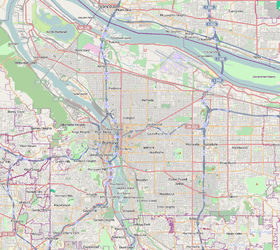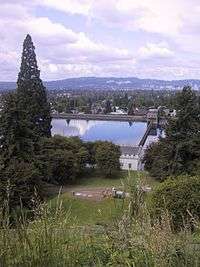Mount Tabor, Portland, Oregon
| Mount Tabor | |
|---|---|
| Neighborhood | |
 Downtown Portland, Oregon, from on Mt. Tabor Park. | |
 Mount Tabor | |
|
Coordinates: 45°30′46″N 122°35′33″W / 45.5128968°N 122.5925937°WCoordinates: 45°30′46″N 122°35′33″W / 45.5128968°N 122.5925937°W PDF map | |
| Country | United States |
| State | Oregon |
| City | Portland |
| Government | |
| • Association | Mount Tabor Neighborhood Association |
| • Coalition | Southeast Uplift Neighborhood Program |
| Area | |
| • Total | 1.60 sq mi (4.14 km2) |
| Population (2000)[1] | |
| • Total | 10,037 |
| • Density | 6,300/sq mi (2,400/km2) |
| Housing[1] | |
| • No. of households | 4316 |
| • Occupancy rate | 96% occupied |
| • Owner-occupied | 2808 households (65%) |
| • Renting | 1508 households (35%) |
| • Avg. household size | 2.33 persons |
| Race Distribution: White 84.6%, Asian 6.4%, Hispanic 3.5%, Black 1.3% | |
Mount Tabor is the name of a volcanic cinder cone, the city park on the volcano, and the neighborhood of Southeast Portland that surrounds it, all in the U.S. state of Oregon. The name refers to Mount Tabor, Israel. It was named by Plympton Kelly, son of Oregon City pioneer resident Clinton Kelly.[2]
Neighborhood

The Mount Tabor neighborhood lies between SE 49th Ave. (SE 50th Ave. south of SE Hawthorne Blvd.) on the west and SE 76th Ave. on the east, and between E Burnside St. on the north and SE Division St. on the south. It is bordered by Sunnyside and Richmond on the west, North Tabor on the north and west, Montavilla on the north and east, and South Tabor on the south.
Mount Tabor Park[3] is the neighborhood's principal feature. The campus of Warner Pacific College (affiliated with the Church of God (Anderson) is located just south of the park. The neighborhood also marks the eastern end of the Hawthorne District. The campus of Western Seminary is located on the western slope, overlooking downtown Portland.
Before becoming part of Portland in 1905, Mount Tabor was a rural farming community dating back to the 1850s. It became a city-recognized neighborhood (encompassing a far smaller area than its historical boundaries) in 1974.[4]
Reservoir controversy
The Mt. Tabor reservoirs, along with those in Portland's Washington Park, have been the subject of a decade-long controversy surrounding lucrative engineering contracts to replace the historic open reservoirs with underground storage tanks. Concern has been raised about the possible relationship between City officials and the engineering firms receiving the no-bid reservoir decommissioning contracts;[5][6] and about the role these parties may have played in lobbying for pro-underground-tank modifications (the "LT2" rule) to the Safe Drinking Water Act.[7]
On June 15, 2011, a man was observed urinating in a nearly 8,000,000 gallon reservoir, prompting city officials to drain the water at a cost of around $36,000.[8]
Under LT2 several hundred of the country's historic open reservoirs were decommissioned.[9]
Following pressure from other open-reservoir cities, in 2011 the EPA softened its stance on the LT2 rule and allowed the country's remaining open reservoirs to halt burial plans;[10] but despite public outcry[11][12] Mt. Tabor's open reservoirs remain slated for decommissioning. In August 2015 the Portland City Council voted for decommissioning, considered to be the final vote on the issue.
See also

- Chauncey Hosford, an early owner of the property at the summit of Mount Tabor
References
- 1 2 Demographics (2000)
- ↑ McArthur, Lewis A.; Lewis L. McArthur (2003) [1928]. Oregon Geographic Names (Seventh ed.). Portland, Oregon: Oregon Historical Society Press. ISBN 0-87595-278-X.
- ↑ http://www.portlandoregon.gov/parks/finder/index.cfm?&propertyid=275&action=ViewPark
- ↑ "Mt Tabor Neighborhood Association - History: The early years of Mt. Tabor". Mttaborpdx.org. Retrieved 2008-11-04.
- ↑ ""Forget it Jake, it's just P-Town," Portland Tribune, December 29, 2003". PortlandTribune.com. Retrieved 2014-05-17.
- ↑ ""A Friend in the Business" Willamette Week, September 10, 2003". WWeek.com. Retrieved 2014-05-17.
- ↑ ""Historical relationship between Montgomery Watson Harza Global, Inc., an Additional Bull Run Treatment Plan, and Portland's Open Reservoirs, and the EPA's 2006 LT2 Rule," Friends of the Reservoirs". FriendsOfReservoirs.org. Retrieved 2014-05-17.
- ↑ "Portland reservoir urination raises few health or scientific concerns -- but it is pee". Oregonlive.com. June 16, 2009.
- ↑ ""Portland, Oregon: A Locus of Undue Influence on Drinking Water Regulations and Public Works Contracts?" PortlandWater.Info" (PDF). PortlandWater.Info. Retrieved 2014-05-17.
- ↑ "United states Environmental Protection Agency: August 2011" (PDF). Opb.org. Retrieved 2013-08-16.
- ↑ ""The Cost of Decommissioning," Southeast Examiner, August 2013". Southeastexaminer.com. Retrieved 2014-05-17.
- ↑ ""Mt. Tabor Reservoir Protest Could Draw Hundreds, Organizer Predicts: Portland City Hall Roundup," The Oregonian, July 11, 2013". OregonLive.com. Retrieved 2014-05-17.
Further reading
- Mount Tabor Park in The Oregon Encyclopedia
- Mount Tabor: Architectural Heritage, 1850–1930 (by Jan Caplener)
- The early years of Mount Tabor (by Grant Nelson)
- East Buttes, Terraces And Wetlands Conservation Plan, Bureau of Planning, Portland, Oregon (1993)
External links
| Wikimedia Commons has media related to Mount Tabor, Portland, Oregon. |
- Mount Tabor Cinder Cone, Portland, Oregon (USGS Cascades Volcanic Observatory)
- Friends of the Reservoirs
- Friends of Mount Tabor, a non-profit group founded in 2000
- Audio from March 2007 news story on KPOJ, about traffic on Mount Tabor
- Mt. Tabor Street Tree Inventory Report